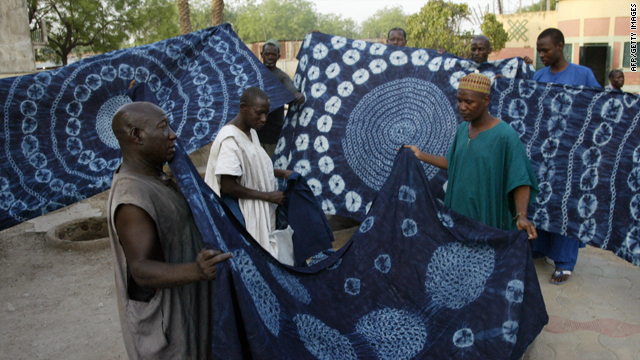Nigeria's 500-year-old dye tradition under threat

- Kano is said to be home to the oldest dye pits in Africa, dating back to 1498
- Indigo, potassium and ash are mixed with water to produce a deep blue dye
- The tradition is under threat from cheap fabric imports from abroad
Kano, Nigeria (CNN) -- Residents of Kano in Nigeria are struggling to keep alive their centuries-old tradition of hand-dying delicate cloth a deep indigo blue, with their trade under threat from the realities of modern commerce.
Kano's pits are said to date back 500 years and were once the center of a bustling Saharan trade in dyed cloth.
There are still over 120 pits in Kano but only 30 of them are functioning. Many of them have been filled in, often because families have moved on to other businesses, but sometimes because they're waiting for their children to grown up, dig out the pit and reclaim their tradition.
Sixty-five-year-old Yusuf Abdu has worked in the dye pits since he was a boy. The pits are family owned and Abdu has trained his 21-year-old son to continue the tradition, but such dedication is rare.
 Gallery: Nigeria's dye pits
Gallery: Nigeria's dye pits
"A lot of our elders have died, so we are calling our families to come back and embrace the work again," said Abdu, who is hoping his son will pass on the knowledge to another generation.
Indigo, potassium and ash are mixed with water in the pits, and then the cloth soaked for up to six hours. The longer it's soaked, the deeper the color.
"We are using the same ways dyers used when the pits began in 1498," explained Abdu.
--Yusuf Abdu, dye pit worker
"We cannot use modern methods because that will change our tradition."
Methods of ironing the cloth are just as traditional; material is beaten with a mallet to remove creases. But these ancient production lines are now being hammered by competition from cheaper foreign fabrics and the rising costs of energy and materials at home.
"There have been a lot of changes. Materials that once cost $10 now cost $40," said Abdu.
Despite its rich history, regional demand for the dyed wares has fallen as fashions have changed, so the dyers are looking to tourists as potential buyers.
Abdu hopes that with their custom the dye trade will continue, as it has for centuries, and that one day his son will be passing on the traditional techniques to his grandson.
